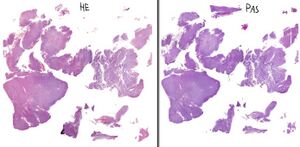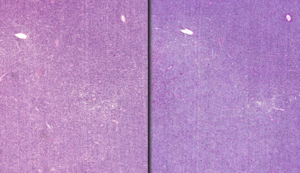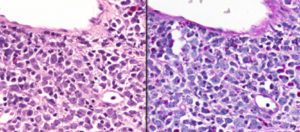18. Diffuse large B-cell lymphoma (DLBCL)
Staining: HE and PAS
Organ: Lymph node (not recognizable)
Description:
No healthy lymph node tissue is visible. The tumor cells form no structures (like glands or nests). The cells are large and show severe atypia/pleiomorphism, almost anaplastic. The cells resemble centroblasts and are therefore said to be centroblastic in appearance or centroblastoid. There is high mitotic activity (many mitotic figures).
On PAS staining are PAS-positive inclusion bodies in the cytoplasm and nuclei visible, so called Russell bodies and Dutcher bodies, respectively. These inclusion bodies are comprised of immunoglobulin.
Diagnosis: Diffuse large B-cell lymphoma.
Causes:
- Primary type: mutations in
- Myc
- BCL2
- BCL6
- Secondary type: Richter transformation from CLL, MZL or FL
Theory:
Necrosis is also a common histological finding in DLBCL but it can’t be seen here.



